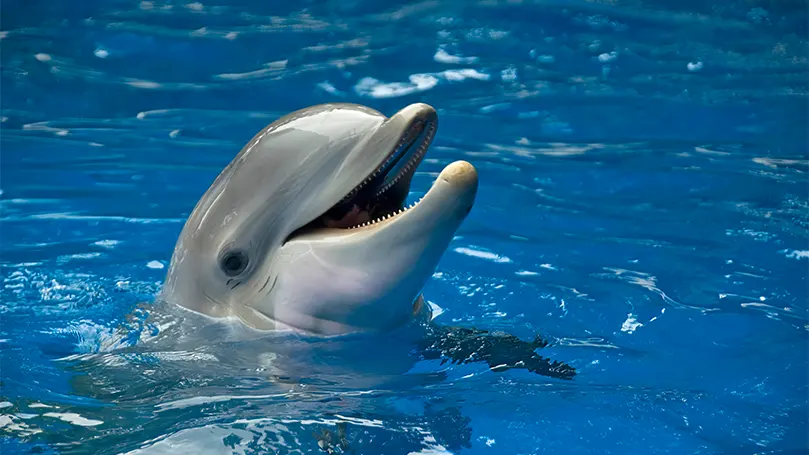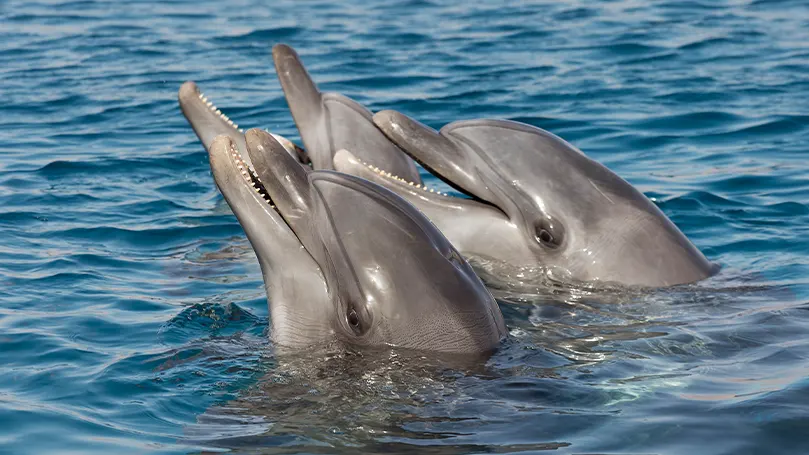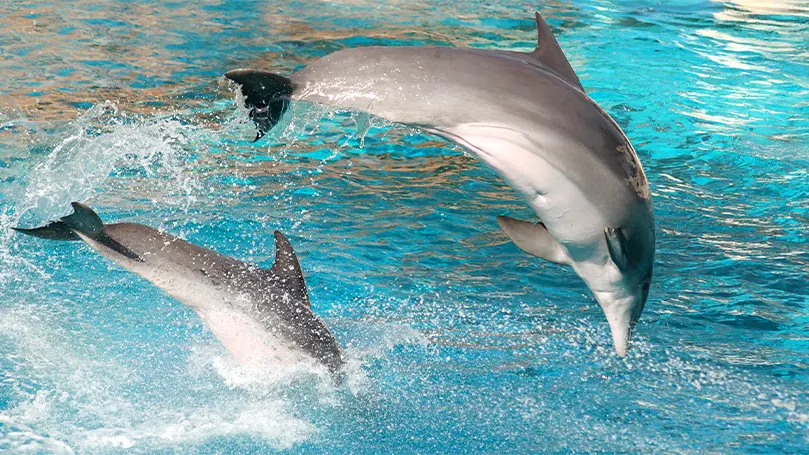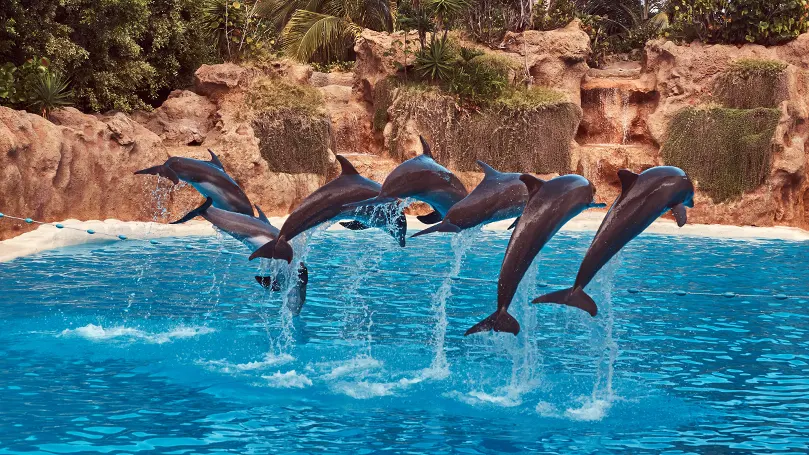Why do dolphins sleep with one eye open?
There are many theories and unanswered questions when it comes to how dolphins sleep. For example, we imagine that scientists were pretty stumped when they first observed that dolphins sleep with one eye open. No, we're not making this up – it’s a real phenomenon that was discovered half a century ago.

And back in the 70s, the theory went that “Dolphins sleep with one eye open so they can keep an eye out for sharks“. And while this is part of the truth, it still doesn't explain the mechanics behind it all. However, it would take some time for scientists to figure out the true purpose of this oddly terrifying sleeping habit. And the answer was arguably even more confusing and fascinating than anyone could have predicted – as you'll soon see.
Do dolphins experience sleep in the same way as humans?
Unlike humans and many other mammals for that matter, dolphins don't have the luxury of REM sleep. At least not in the way we're used to. Instead, they experience something called a “unihemispheric slow-wave sleep,” where only half their brain sleeps at a time. The other half remains alert, keeping an eye out for predators and other dangers, as they have to be constantly on the lookout for predators.

Since their brain is kind of similar to ours, it shouldn't come as a surprise that if a dolphin “shuts off” the right side of the brain, its left eye remains open. And if the left side of the dolphin's brain is “turned off,” then the right eye stays open. Dolphins usually cycle between their hemispheres every two hours or so, and this pattern is called cat-napping.
But, this is not just due to predators. Dolphins also don't have the ability to breathe automatically as we do, so they have to be conscious to remember to surface and take a breath. If they were to fall into a deep sleep as humans do, they would simply forget to breathe and would eventually die. Therefore, if you've ever had a moment where you started “manually breathing”, you've experienced what it's like to be a dolphin.
How do dolphins sleep?
Okay, so now we know that dolphins basically juggle their brain activity and can't ever turn on autopilot while asleep. That's already weird enough. But how do they sleep and where do they do it? After all, there's a big difference between having a waterbed mattress and sleeping in the ocean!
Do they go to the bottom of the ocean and hope for the best? Or do they have some specific technique? Well, as it turns out, they have two distinct methods for catching some ZZZs in the wild.
Sleep logging
As you can probably tell by the name, sleep logging is when a dolphin looks like it's floating on the surface of the water, almost like a log. This is a deeper form of sleep that dolphins enter, often at night.
And if you're an enjoyer of animal sleep facts, you'd know that whales do something very similar. Although admittedly their method definitely scared a few sailors back in the day. And for lighter sleep, dolphins take little naps while swimming.
Echelon swimming
Another way that dolphins sleep is by swimming slowly next to another animal. This is called echelon swimming.
When dolphins do this, they are usually mother dolphins with their calves. The mother dolphin will tow the calf along in her slipstream while she eats, rests, and sleeps. This is because dolphin calves cannot stop swimming for a few weeks after they are born. If they did, they would sink because they don't have enough body fat to keep them afloat.

Do dolphins sleep at night?
Dolphins are known to be diurnal animals, meaning that dolphins generally sleep during the night and are active during the day. However, this isn't set in stone, as dolphins have been known to be active at night on occasion.
As we've previously mentioned, dolphins can't enter into a deep sleep as humans do. Instead, only one brain hemisphere sleeps (unihemispheric sleep) while the other one's alert, allowing them to breathe, watch out for danger, but also – eat.

During the night, dolphins will often swim slowly near the surface, munching on small fish or squid. So, perhaps humans and dolphins are more alike than we'd like to admit.
As for how long they sleep, it's estimated that bottlenose dolphins sleep for around 8 hours a day, but this can vary depending on the dolphin's age, health, and activity level.
Is it possible for bottlenose dolphins or other marine mammals to drown?
This is a bit difficult to answer, especially if you take semantics into account. In order for a creature to drown, by definition it has to inhale water. However, dolphins are very unlikely to do that. This is because they can't breathe through their mouth and their blowhole is specifically designed to keep water out.
That being said, if a dolphin dives too deep or can't reach the surface, it can suffocate. This often happens when they are caught in fishing nets. So, while the end result is much the same, semantically speaking, dolphins suffocate rather than drown most of the time.
How do dolphins sleep without suffocating?
The crucial factor that helps dolphins and other marine mammals live underwater without drowning is their blowhole. As we've mentioned, unlike humans, dolphins exclusively breathe through their blowhole while their mouth is only used for eating. And this means that they can't accidentally breathe in air while eating.
The blowhole is a flap of skin that is believed to open and close under the voluntary control of the animal. This means that the brain has to “give the thumbs up” in order for a dolphin to exhale and then inhale fresh air. Dolphins also exhale first, pushing aside all the water and allowing the dolphin to get a deep breath without worrying about water coming into their lungs.
On top of this, marine mammals, like whales and dolphins, have lungs that are larger than other types of mammals. This helps them to take in more air with each breath meaning that they have to go up to the surface less frequently. And their red blood cells also carry more oxygen. Plus when they dive, their blood prioritises only those parts of the body that need to be active, like the brain, heart, and their fin.
Finally, these animals can handle higher levels of carbon dioxide (CO2). Their brains don't tell them to breathe until the levels of CO2 are much higher than what, we, for example, could ever handle. This is called the marine mammal diving response and when combined with everything we've mentioned so far allows dolphins to live the way they do.
How long do dolphins sleep for?
Generally speaking, a bottlenose dolphin will sleep for around 8 hours a day or around 30% of the day. So, they actually have a similar sleep duration to a human's optimal sleep length.
However, as we've mentioned before, only one half of the brain is sleeping at any given point. So, depending on how you look at it, you could say that dolphins only sleep for 4 hours.
Do dolphins sleep in groups?
Considering that dolphins sleep with one eye open in order to stay safe, it shouldn't be much of a surprise to learn that they also tend to stick together while sleeping. After all, there's safety in numbers and this marine mammal system isn't exclusive to only dolphins!

Adult male dolphins often swim in pairs. They will line up side by side and sleep while swimming slowly in the same direction.
Females and young calves, on the other hand, will often sleep while huddled together in groups, called pods. This behaviour offers them some protection against predators and also allows for more efficient echelon swimming.
Conclusion
There you have it – pretty much everything you need to know about dolphin sleep. Do they sleep in pods? Yes. Do they sleep with one eye open? Yes. Can they drown if they don't maintain control of their blowhole? Technically, no, but they could die. Do you have any more questions about dolphin sleep? Let us know and we'll find the answer for you!













There are no comments yet
"*" indicates required fields